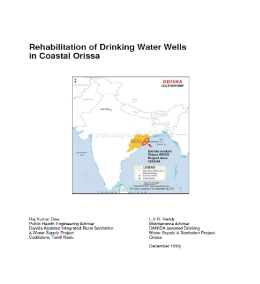RWSN Library

Author
Raj Kumar Daw, L.V.R. Reddy
Year of Publishing
1993
Publisher
Institution
Rehabilitation of Drinking Water Wells in Coastal Orissa
Description:
The Danida assisted Orissa Drinking Water Supply Project started in August 1985 with the
intention of constructing 10,500 tubewells in 20 blocks of coastal Orissa. By 1991, about 4500
hand pumps had been installed on tube wells in 12 blocks of the project area.
The Functionality Study of Hand Pumps in the project of November 1987 indicated that a
significant number of pumps were wholly or partially rejected by users. Subsequently, a series
of technical studies established that water quality from wells in the project area had
deteriorated with time, that well construction quality needed to be improved and there was need
to develop a clearer understanding of hydro-geological and hydrochemical phenomena in the
project area before further large scale well construction could resume.
However, the question of rehabilitation of 4500 wells already constructed needed a different
approach. Little experience was available on remediation techniques for such a large scale and
geographically dispersed water supply programme. The problem was further compounded by
the deltaic conditions of coastal Orissa.
Though well rehabilitation specifications and guide lines are available, for restoration of
decreased yields, the problem was complicated as 90% of the wells identified for rehabilitation
were on the basis of quality deterioration.
After some inconclusive trials in one block during 1989-90, the project undertook its
Experimental Rehabilitation Programme on 47 wells in one block in 1991, followed by the Pilot
Rehabilitation Programme on 87 wells in 1991-92, spread over four blocks with a wider range
of rehabilitation problems. These programmes led to the development of a logical evaluation
procedure of rehabilitation results and set the direction for the regular rehabilitation
Implementation Programme of the project. By the latter part of 1993 results of rehabilitation of
about 900 wells were available.
This paper presents the results of the rehabilitation programme. It examines the results on the
basis of a range of criteria such as geographical area, depth ranges of wells and methods of
well cleaning. The results are also classified into four degrees of success of rehabilitation, from
Fully Successful, to Partially, Doubtful and Not Successful.
The results of data analysis leads to a conclusion that rehabilitation was fully successful in 28%
and 45% wells in the Experimental & Pilot Programmes and the Implementation Programme
respectively. Similarly, rehabilitation failed in 47% to 22% wells in the respective programmes.
These conclusions raise serious doubts about the long term viability and sustainability of a rural
drinking water supply programme based on ground water and tubewells in coastal Orissa.
Bibliographical Information:
Raj Kumar Daw, L.V.R. Reddy (1993) Rehabilitation of Drinking Water Wells in Coastal Orissa.
DOWNLOADS (16)
Rehabilitation of Drinking Water Wells in Coastal Orissa
 Google Übersetzer
Google Übersetzer
